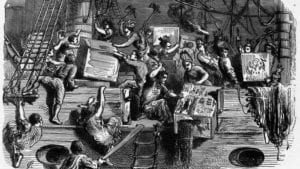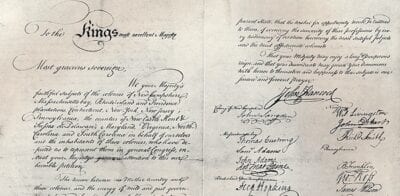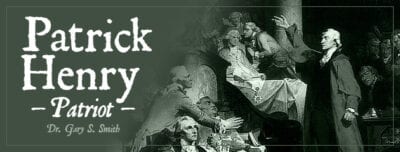(Jan 1, 1735 – ) Patriot who enjoys a special place in American history for his role in the American Revolution. Revere leveraged his business and political connections in support of American patriots and is most famous for his ride to alert Colonial militia members of the approach of British troops. Less known history includes his involvement in the creation of the Colonial intelligence system monitoring the British military and his tenure as a military officer during the American Revolutionary War.
Early Life
 Paul Revere spent his childhood in Boston and was the third of twelve children. His father, born Apollo Rivoire, was a French Huguenot who immigrated to America at age 13 and apprenticed to a silversmith in Boston. His mother, Deborah Hitchborn, was the daughter of a Boston family owning a small shipping wharf. At the age of 13, Revere left school and became his father’s apprentice in his silver shop. Unfortunately, his father died before Revere was old enough to legally take over his shop. In the interim, he joined the provincial army in 1756 and spent the summer at Fort William Henry in New York. After a short military stint, he returned to Boston and took over the silver shop. Revere wed his first wife, Sarah Orne, on August 4, 1757 and their first child arrived eight months later.
Paul Revere spent his childhood in Boston and was the third of twelve children. His father, born Apollo Rivoire, was a French Huguenot who immigrated to America at age 13 and apprenticed to a silversmith in Boston. His mother, Deborah Hitchborn, was the daughter of a Boston family owning a small shipping wharf. At the age of 13, Revere left school and became his father’s apprentice in his silver shop. Unfortunately, his father died before Revere was old enough to legally take over his shop. In the interim, he joined the provincial army in 1756 and spent the summer at Fort William Henry in New York. After a short military stint, he returned to Boston and took over the silver shop. Revere wed his first wife, Sarah Orne, on August 4, 1757 and their first child arrived eight months later.
Professionally, Revere is most well-known for his silversmithing skills. As a silversmith, he also had the ability to engrave and decorate his own pieces. As a result, his reputation in Boston quickly grew and over 5,000 pieces were produced by his shop. Later in life, Revere worked in other fields including dentistry and metal work using materials other than silver.
Political Connections
Revere’s silver shop kept him in close proximity to many business leaders in Boston. His reputation as a silversmith and engraver brought him a great deal of business and exposed him to many influential members of Boston society. Due to his childhood in Boston and connections to other leading families, Revere socialized with many of the men associated with the revolutionary movement.
He was also a founding member of the Masonic Lodge of Boston. While the source of his interest in freemasonry is not certain, he may have been introduced to it during his first military service. Revere likely continued his exposure to freemasonry while frequenting Boston’s public houses. In addition to the political influence of the lodge, Revere’s business also benefited from his opportunity provided by the society to meet and mix with multiple social classes.
Seeds of Revolution
In addition to the influence of the Masonic Lodge and his local ties, Revere experienced business setbacks resulting from British rule. His silver shop suffered due to downturns in the British economy and the passage of the Stamp Act of 1765. He sought other ways to support his family, such as dentistry, as his business declined. While he dealt with the financial burdens imposed by British rule, Revere continued to meet with and support local militants and protest groups. He was a founding member of the Sons of Liberty, formed in 1765.
Revere used his skills and business to support protests against British rule. Examples include engravings and silver pieces made to depict images designed to further inflame the populace against continuing British rule. He participated in protest activities such as guard duty to prevent the off-loading of taxable tea from the Dartmouth and the subsequent Boston Tea Party activities.
Beginning in December 1773, Revere rode as a courier to New York and Philadelphia on behalf of the Boston Committee of Public Safety. He provided reports on the political situation and unrest in Boston and his rides were monitored by British intelligence. During this time, General Thomas Gage, the military governor of Massachusetts, forced citizens of Boston to provide lodging to British soldiers and closed the port.
Revere, along with 30 others, began meeting and laying plans to gather and share intelligence about British troop movements and activities. At the same time, he used his skills by providing engravings to a monthly patriot publication, the Royal American Magazine. In December 1774, Revere rode to Portsmouth, New Hampshire to warn of a possible impending British landing. While the rumors were unfounded, his ride inspired locals to raid Fort William and Mary for the supply of gunpowder stored there.
Midnight Ride
 In the weeks leading up to the Battles of Lexington and Concord, British Army activity indicated a possibility of troop movement. As a result, Revere was sent to Concord to warn the Massachusetts Provincial Congress. As a result, residents began moving military supplies stored in Concord to other locations in preparation of potential British action. In addition to providing this warning, Revere worked with Robert Newman, the sexton of the North Church, to develop a warning system to indicate the route of the British army should they take action. The famous line “one if by land, two if by sea” refers to the number of lanterns to be lit in the church steeple depending on whether British troops chose the land route or the water route across the Charles River.
In the weeks leading up to the Battles of Lexington and Concord, British Army activity indicated a possibility of troop movement. As a result, Revere was sent to Concord to warn the Massachusetts Provincial Congress. As a result, residents began moving military supplies stored in Concord to other locations in preparation of potential British action. In addition to providing this warning, Revere worked with Robert Newman, the sexton of the North Church, to develop a warning system to indicate the route of the British army should they take action. The famous line “one if by land, two if by sea” refers to the number of lanterns to be lit in the church steeple depending on whether British troops chose the land route or the water route across the Charles River.
On the night of April 18, 1775, acting upon orders from Gage, British troops moved out, ostensibly to capture Samuel Adams and John Hancock. In actuality, the capture of the two rebel leaders was a portion of the goal, but the primary goal was the seizure or destruction of rebel military stores in and near Concord. Based on information about the troop movements, Revere and William Dawes set out to warn their leaders and alert local militias of the British activities.
Throughout the night of April 18, Revere warned numerous patriots along his route to Lexington. His alert sparked additional riders to continue carrying the message to other militias while he continued towards Lexington. Upon arrival, he and Dawes met with Hancock and Adams and laid plans for opposing the British troops. After leaving Lexington, they proceeded to Concord, but were stopped by a British roadblock before reaching the city. Despite being captured and questioned by the British, the ride triggered the alarm and muster plan used to provide rapid warning and notification to colonial militias. As a result, the militia had enough notice to repel British troops in Concord.
Military Assignments
Following his midnight ride, Revere remained useful to the rebel cause in several different ways. While he was initially denied a military commission, he served as a courier and printer for the provincial congress. Revere also researched an existing powder mill and obtained enough information to set up another mill at Stoughton, which produced tons of gunpowder used by the colonial forces.
Revere eventually received a military commission and served in both the infantry and the artillery. While he was typically second or third in the command structure, he did hold command at Castle William in Boston several times. During his tenure here, he instituted several improvements in the fort’s armaments and developed a caliper to measure cannon balls and bore holes. While stationed at Castle William, Revere participated in several small-scale sorties, including prisoner escort duties and an aborted attempt to capture a British base at Newport, Rhode Island.
A low point of Revere’s military career was the Penobscot disaster. In this attempt to push the British out of a new base established on Penobscot Bay, Revere held command of the artillery units. Due to conflicting opinions and orders, the overall expedition was chaotic and unsuccessful. Despite some artillery successes, Revere found himself in difficult circumstances during the battle. He was separate from his men and had to move overland to regroup his troops. He faced charges resulting from the engagement and was not exonerated for several years.
After the War
 Following the war, Revere continued to find success as a tradesman. He engaged in hardware and home goods sales and eventually opened a foundry to cast brass and iron. In his foundry, he gained a strong reputation for casting church bells while also producing a significant amount of iron bolts and fittings for ship construction. Revere also pioneered the production of copper plating and opened the first copper mill in North America. Revere also remained active in politics throughout his lifetime and involved in community issues.
Following the war, Revere continued to find success as a tradesman. He engaged in hardware and home goods sales and eventually opened a foundry to cast brass and iron. In his foundry, he gained a strong reputation for casting church bells while also producing a significant amount of iron bolts and fittings for ship construction. Revere also pioneered the production of copper plating and opened the first copper mill in North America. Revere also remained active in politics throughout his lifetime and involved in community issues.
Paul Revere is one of the best known figures of the American Revolution. While he is best known for his work of one night, he was a full and active participant in numerous revolutionary activities. In addition to his role in the Revolution, Revere was also a leading figure in the development of the new nation’s economic and political structures.
Chronological History of Events Involving Paul Revere

Paul Revere’s Midnight Ride Warning the Patriots that the British were Coming

Seizure of Fort William & Mary at Newcastle

Paul Revere’s First Ride: Warns the Citizens of New Hampshire that the British were Coming to Seize Firearms & Gunpowder




